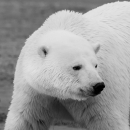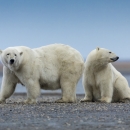Monitoring, Research
Indices of body condition in wildlife can serve as valuable indicators of population health, and often provide insights into reproductive success and survival. We are partnering with the National Park Service to test and validate multiple methods for noninvasively estimating body mass of bears, including 1) terrestrial laser scanning technology, 2) ground-based single photo methods, and 3) aerial photogrammetry. This project evaluates methods generally applicable in bears, but specifically indices in polar and black bears.






